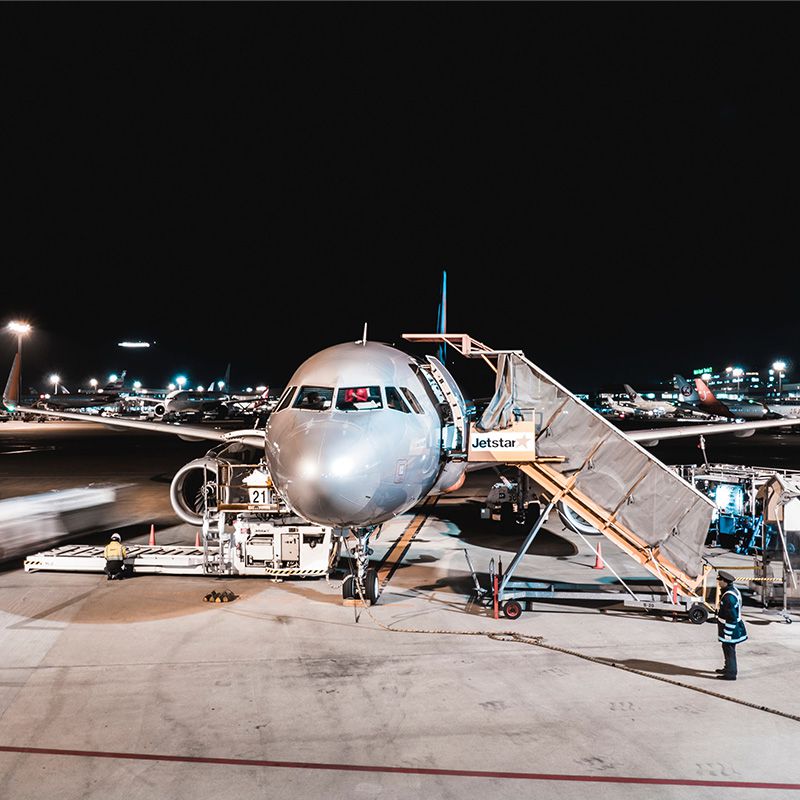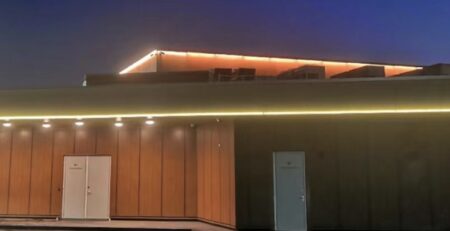Ultimate Guide to Airport Lighting: Runway Lights, Colors & Systems
Airport lighting is an essential component of ensuring safe aircraft operations. Consisting of various lighting systems, including runway lights, airfield lights, approach lights, and runway edge lights, it plays a crucial role in guiding pilots during takeoff and landing procedures. Among these systems, the use of LED lighting, including approach lights, centerline lights, threshold end lights, and threshold lights, has gained significant prominence in recent years due to its numerous advantages.
Table of Contents
Intro
LED lighting systems offer several benefits for airport lighting design, particularly in terms of efficiency and durability. The use of outdoor LED lighting, such as LED floodlights, enhances visibility on airfields and taxiways, improving pilot navigation even during adverse weather conditions. The ALS system, equipped with red LED lights, plays a crucial role in guiding pilots during landing and takeoff. By providing bright and uniform illumination, airports can ensure enhanced safety measures.
Moreover, the strategic placement of these red lights helps pilots accurately gauge their position relative to the airfield runway and other critical areas of the lighting system. With proper airport lighting design, the risk of accidents or incidents related to poor visibility is significantly reduced.
In conclusion, airport lighting is a vital aspect of aviation infrastructure that ensures safe operations by guiding pilots during takeoff and landing procedures. The utilization of LED lighting systems offers improved visibility and enhances overall safety measures at airports worldwide.


Importance of Effective Airport Lighting
Enhances visibility in low-light conditions
Effective airport lighting plays a crucial role in enhancing visibility during low-light conditions. Airports operate around the clock, and it is essential to ensure that pilots have clear visibility even during nighttime or adverse weather conditions. This is why runway lighting and a reliable lighting system are crucial. This is why runway lighting and a reliable lighting system are crucial. By strategically placing a lighting system along runways, taxiways, and other critical areas, airports can significantly improve visibility for pilots.
During takeoff and landing, pilots rely heavily on visual cues provided by the runway lighting system to navigate the aircraft safely on the airport runway. Adequate lighting allows them to identify the runway’s edges, centerline markings, and approach path more easily. This reduces the risk of misjudgments or errors that could lead to accidents or runway incursions.
Furthermore, proper lighting also assists ground personnel in their tasks. Maintenance crews, baggage handlers, and other workers need good visibility to perform their duties efficiently and safely. Well-lit aprons and taxiways enable them to navigate through complex airport layouts with ease.
Reduces the risk of accidents and collisions
One of the primary reasons for implementing effective airport lighting is to reduce the risk of accidents and collisions. The aviation industry places great emphasis on safety measures, and adequate lighting is a crucial component of this effort.
Properly lit runways help pilots maintain situational awareness while operating at high speeds during takeoff or landing. Bright lights along runway edges allow pilots to accurately judge their position relative to the centerline, reducing the likelihood of veering off course.
In addition to runway lighting, airports also utilize various types of approach lights such as strobes or sequenced flashing lights (SFLs). These lights provide additional guidance during final approaches by indicating glide slope deviations or signaling distance remaining until touchdown. They serve as valuable aids for pilots when navigating through challenging weather conditions like fog or heavy rain.
Facilitates smooth air traffic control
Effective airport lighting facilitates smooth air traffic control operations by providing clear visual references for controllers. Air traffic controllers rely on accurate position reporting from pilots, but visual confirmation through lighting systems adds an extra layer of safety.
By having a clear view of the runways and taxiways, controllers can better coordinate aircraft movements, ensuring efficient departures and arrivals. This reduces the chances of conflicts or delays caused by miscommunication or misunderstandings.
Moreover, airport lighting also aids in ground movement control. By illuminating taxiways and aprons, it becomes easier for controllers to guide aircraft to their designated gates or parking positions. This streamlines ground operations and minimizes the risk of collisions between aircraft or with other airport vehicles.
Significance and Meaning of Runway Light Colors
White Lights Indicate the Edges of Runways
The use of white lights on runways serves a crucial purpose in ensuring safe aircraft operations. These lights are strategically placed along the edges of runways to provide pilots with clear visibility, especially during low-light conditions or adverse weather situations. The bright illumination offered by outdoor LED lighting systems enhances the visibility of these runway edges, allowing pilots to maintain their course accurately.
White lights play a pivotal role in guiding pilots during takeoff and landing procedures. By delineating the boundaries of the runway, they help pilots align their aircraft precisely and prevent any potential veering off-course. This is particularly important at night when visual cues are limited, making it essential for airport lighting design to prioritize effective edge marking using white LED floodlights.
Yellow Lights Signal Caution or Hold Positions
Yellow lights serve as cautionary signals for pilots on the airfield. They indicate specific areas where extra attention must be paid or where aircraft should hold the position until further instructions are received. These hold positions may include taxiway intersections, holding bays, or other critical points along the runway.
The color yellow is chosen deliberately due to its distinctiveness and ability to catch attention amidst other colors used in airport lighting. When illuminated by LED floodlights, yellow light stands out even more prominently against its surroundings, ensuring that pilots can easily identify these cautionary areas and adhere to operational protocols.
Green Lights Signify the Threshold or Approach End of a Runway
Green lights have a specific significance at airports as they mark the threshold or approach the end of a runway. Pilots rely on these green LED lights to determine their position relative to the beginning of a runway while approaching for landing. The well-defined green color provides an unmistakable indication that helps aviators maintain proper alignment during this critical phase.
By incorporating green LED lighting systems into airport runways, aviation authorities ensure that pilots have a clear visual reference point, enhancing their situational awareness and reducing the risk of misjudgment. The distinct color and brightness of green lights provide pilots with confidence as they approach the runway threshold.
Types of Airport Lighting Aids
Approach Lighting Systems Guide Pilots During Landing
Approach lighting systems play a crucial role in guiding pilots during the landing phase. These systems are strategically placed along the approach path to provide visual cues that aid in aligning the aircraft with the runway and ensuring a safe descent. The primary purpose of approach lighting is to enhance visibility, especially during adverse weather conditions or at night.
There are various types of approach lighting aids used at airports worldwide. Here are some examples:
- Precision Approach Path Indicators (PAPI): PAPI lights consist of a row of red and white lights located beside the runway. By observing the color combination, pilots can determine if they are on the correct glide slope for landing. If they see more red lights, it indicates that they are too low, while more white lights indicate being too high.
- Visual Approach Slope Indicator (VASI): Similar to PAPI lights, VASI uses a combination of red and white lights to guide pilots during their final approach. However, VASI lights are typically installed on both sides of the runway and offer additional information by displaying different light combinations depending on the aircraft’s position relative to the ideal glide path.
Taxiway Lights Assist Aircraft Movement on the Ground
Once an aircraft has safely landed, taxiway lights become essential for its movement on the ground. These lights help pilots navigate between runways, terminals, hangars, and other areas within an airport complex. They ensure smooth traffic flow and prevent any potential collisions or confusion among aircraft.
Some common types of taxiway lights include:
- Edge Lights: Positioned along the edges of taxiways, these blue-colored lights provide clear boundaries for pilots during nighttime operations or low visibility conditions.
- Centerline Lights: Installed down the centerline of taxiways, centerline lights assist pilots in maintaining proper alignment while maneuvering their aircraft. These green lights are particularly useful during taxiing at night or in adverse weather.
Apron Floodlights Illuminate Parking Areas for Planes
Apron floodlights serve a vital purpose in illuminating the parking areas where planes are stationed, commonly known as aprons. These floodlights ensure adequate visibility for ground crew members and pilots during aircraft parking, maintenance, and other related activities.
Here are some key features of apron floodlights:
- High Intensity: Apron floodlights are designed to emit bright and powerful light to cover large areas effectively. This high-intensity illumination enhances safety by minimizing the risk of accidents or incidents due to poor visibility.
- Directional Control: These floodlights can be adjusted to focus their beam on specific areas within the apron, allowing targeted lighting where it is needed most. This flexibility ensures that critical operations such as refueling or cargo loading can be carried out with precision.
Runway Edge Light Systems: Enhancing Visibility
Runway edge light systems play a crucial role in ensuring the safe operation of airports, particularly during nighttime or poor weather conditions. These systems are designed to mark the edges of runways, providing pilots with essential visual cues for maintaining proper alignment during takeoff and landing. By using advanced LED lighting technology, these systems offer enhanced visibility and contribute to the overall safety of airport operations.
– Centerline Lights
One key feature of runway edge light systems is their ability to utilize different colors to indicate various parts of the runway. For instance, white lights are typically employed along the runway’s centerline, guiding pilots with precision during approach and departure. These lights ensure that aircraft remain aligned with the designated path, minimizing the risk of veering off course.
– Runway Edge Lights
In addition to centerline lights, runway edge lights are strategically placed along both sides of the runway. These lights emit a steady green color that helps pilots identify the edges even in low-visibility conditions. The clear distinction between the illuminated runway surface and surrounding areas assists pilots in maintaining spatial awareness and making accurate judgments during critical phases such as landing.
– Taxiway Lights
To further enhance visibility and situational awareness, airport lighting design incorporates taxiway lights that connect runways with parking areas and terminal buildings. These lights often use LED floodlights to illuminate taxiways brightly. By providing a well-lit pathway for aircraft movement on the ground, taxiway lights facilitate safe navigation throughout an airport’s complex network of runways and taxiways.
– Threshold End Lights
Threshold end lights are another vital component of airport lighting systems. Positioned at both ends of a runway threshold, these lights emit a pulsating white color to indicate their boundaries clearly. This distinct visual cue is essential for pilots when determining where they should initiate takeoff or commence landing procedures.
– Optimizing Visibility and Safety
The primary objective behind all these lighting arrangements is to optimize visibility for pilots while ensuring precise maneuvering on runways and taxiways. Properly designed airport lighting not only enhances safety but also minimizes the risk of accidents caused by reduced visibility or misalignment.
Obstruction Aviation Lights: Ensuring Safety
Obstruction aviation lights play a crucial role in ensuring the safety of pilots and aircraft during takeoff and landing. These lights are strategically installed on tall structures such as buildings, towers, or cranes to warn aircraft about potential obstacles that could pose a threat to their flight path. Let’s delve into the significance of these lights and how they contribute to preventing collisions.
– Enhancing Visibility for Pilots
One of the primary functions of obstruction aviation lights is to increase visibility for pilots. When an airport lighting design incorporates outdoor LED lighting systems, it significantly enhances the visibility of obstacles for pilots during critical phases of flight. LED floodlights are particularly effective in illuminating tall structures, making them easily distinguishable from afar. By providing clear visual cues, these lights help pilots navigate safely around potential hazards.
– Standardized Light Colors
To ensure optimal safety standards, obstruction aviation lights emit red or white flashing lights based on regulations established by aviation authorities. Red flashing lights are typically used during nighttime operations, while white flashing lights are employed during daytime operations. This standardized approach allows pilots to quickly identify and assess potential obstructions regardless of the time of day.
– Mitigating Collision Risks
The installation of obstruction aviation lights is especially vital near airports where there may be numerous tall structures in close proximity to runways. Without these warning signals, pilots might have difficulty spotting buildings or towers amidst other cityscape elements. The use of obstruction aviation lights mitigates this risk by clearly marking out any obstructions that could impede safe takeoff or landing procedures.
Enhancing Situational Awareness
Consider a scenario where an airplane is preparing for takeoff at dusk. As it taxis towards the runway, the pilot’s attention is focused on various tasks involved in pre-flight checks and communication with air traffic control. In such situations, if there were no obstruction aviation lights installed on nearby structures like cranes or antennas, it would be challenging for the pilot to notice them promptly.
By having these warning signals in place, however, pilots can easily identify the presence of obstacles and adjust their flight path accordingly. This simple yet effective measure significantly reduces the likelihood of collisions or near misses, ensuring the safety of both pilots and aircraft.
Runway End Identification Light (REIL): Enhancing Visibility
Runway End Identification Lights (REIL) are an essential component of airport lighting design, strategically positioned at the end of runways to enhance visibility during the approach. Consisting of synchronized flashing lights, REIL systems assist pilots in identifying runway thresholds from a distance, ensuring safe landings and takeoffs.
– Providing Visual Guidance
The primary purpose of REIL is to provide visual cues that guide pilots towards the beginning or end of the runway. These lights are typically installed on both ends of the runway and emit a bright, pulsating light that captures attention even in adverse weather conditions. By utilizing advanced LED lighting systems, airports can ensure maximum visibility while minimizing energy consumption.
– Enhancing Safety in Low Visibility
When approaching an airfield, pilots rely on various lighting aids to navigate safely. The Runway End Identification Lights play a crucial role in this process by alerting pilots about their proximity to the runway threshold. This information is particularly vital during low-visibility situations or nighttime operations when the visual reference points may be limited.
– Preventing Runway Overshoots and Undershoots
The installation of REIL systems has significantly improved aviation safety by reducing the risk of overshooting or undershooting runways. Pilots can now confidently identify the end of a runway from afar, allowing for precise landing approaches. The synchronization feature ensures that both lights flash simultaneously, providing clear indications regardless of the pilot’s position relative to the runway.
– Color Configuration for Differentiation
An important aspect of REIL systems is their color configuration. Typically, one set of lights emits white flashes while another set displays red flashes. The combination helps differentiate between approach and departure ends of runways effectively. The red lights mark the beginning or departure end, while white lights indicate the opposite direction.
– Complementing Other Airport Lighting Systems
In addition to aiding pilots visually, REIL systems also complement other airport lighting components such as Instrument Landing Systems (ILS) and Approach Lighting Systems (ALS). Together, these elements create a comprehensive network that guides aircraft throughout their descent and landing procedures.
Ensuring Safe Operations with Airport Lighting
In order to ensure safe operations at airports, effective airport lighting plays a critical role. The importance of such lighting cannot be overstated, as it enhances visibility and provides crucial guidance for pilots during takeoff, landing, and taxiing. By understanding the significance and meaning of runway light colors, airports can effectively communicate information to pilots about the conditions on the runway. Different types of airport lighting aids further contribute to safety by illuminating runways, identifying obstructions, and enhancing visibility.
To optimize safety measures at airports, it is essential to invest in reliable airport lighting systems that adhere to industry standards. These systems not only enhance visibility but also improve overall operational efficiency. With proper lighting infrastructure in place, pilots can confidently navigate runways regardless of weather conditions or time of day. Ensuring compliance with regulations governing airport lighting is crucial for maintaining high levels of safety.
For more detailed insights into airport lighting and its impact on aviation safety, continue reading the sections completed before this conclusion. Understanding the different types of airport lighting aids will provide a comprehensive overview of how these systems work together to create a secure environment for air travel.
FAQs
What are the specific requirements for runway edge lights?
Runway edge lights must be spaced at regular intervals along both sides of the runway and emit a consistent color (typically white or yellow). These lights should be visible from long distances to aid pilots in maintaining their position on the runway during low visibility conditions.
How do obstruction aviation lights ensure safety?
Obstruction aviation lights are used to identify tall structures or objects near airports that could pose a hazard to aircraft. These lights help pilots identify potential obstacles from afar and take appropriate action to avoid them.
What purpose does Runway End Identification Light (REIL) serve?
Runway End Identification Lights (REILs) consist of synchronized flashing lights placed at each end of a runway. They assist pilots in identifying the beginning and end of a runway, especially during nighttime or low visibility conditions.
Are there any regulations governing airport lighting?
Yes, there are regulations set by aviation authorities that govern the design, installation, and maintenance of airport lighting systems. Compliance with these regulations is crucial to ensure consistent safety standards across airports.
How does airport lighting contribute to operational efficiency?
Airport lighting aids in improving operational efficiency by allowing for uninterrupted flight operations during nighttime hours or adverse weather conditions. It enables pilots to safely navigate runways and taxiways, minimizing delays and optimizing overall airport performance.





